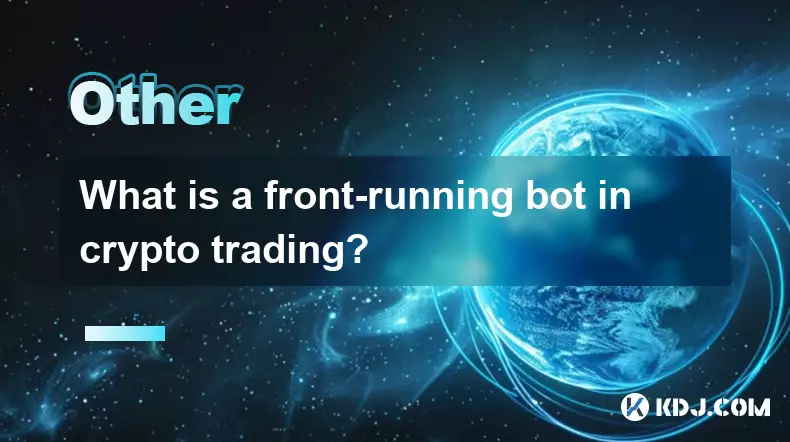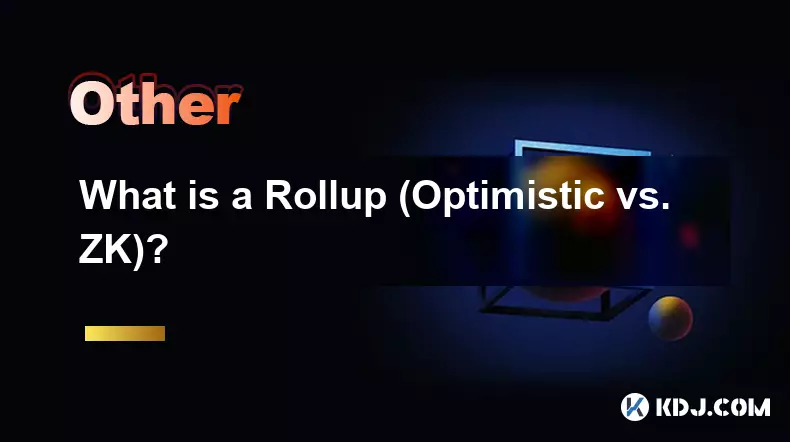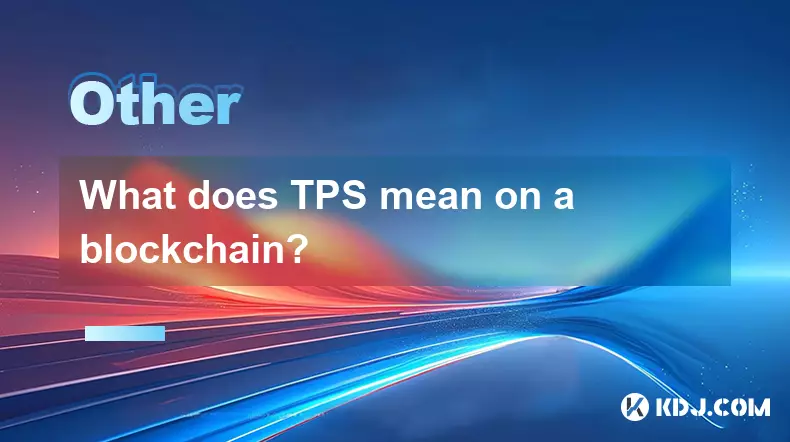-
 bitcoin
bitcoin $114779.865156 USD
2.30% -
 ethereum
ethereum $4226.519789 USD
2.39% -
 tether
tether $1.000545 USD
0.04% -
 xrp
xrp $2.890223 USD
0.92% -
 bnb
bnb $1030.029301 USD
2.95% -
 solana
solana $212.824944 USD
1.69% -
 usd-coin
usd-coin $0.999757 USD
0.01% -
 dogecoin
dogecoin $0.234961 USD
-0.27% -
 tron
tron $0.337174 USD
0.42% -
 cardano
cardano $0.804783 USD
0.09% -
 hyperliquid
hyperliquid $45.748770 USD
-2.85% -
 chainlink
chainlink $21.699170 USD
0.82% -
 ethena-usde
ethena-usde $1.001452 USD
0.08% -
 avalanche
avalanche $30.237800 USD
1.14% -
 stellar
stellar $0.372604 USD
1.52%
What is a front-running bot in crypto trading?
Front-running bots exploit public mempools to profit from pending trades, leveraging speed and higher fees to execute ahead of retail traders, undermining market fairness.
Sep 07, 2025 at 12:55 pm

Understanding Front-Running Bots in Crypto Trading
1. A front-running bot is an automated trading program designed to detect and exploit pending transactions in a blockchain’s mempool before they are confirmed. These bots scan the network for large trades or limit orders and execute their own transactions ahead of them to profit from the resulting price movement. This practice is enabled by the transparent nature of public blockchains, where unconfirmed transactions are visible to anyone monitoring the network.
2. In decentralized exchanges (DEXs), where trades are executed through smart contracts and users interact directly with the blockchain, front-running becomes technically feasible. When a user submits a trade, it enters the mempool—a pool of unconfirmed transactions. Bots constantly monitor this space and identify profitable opportunities, especially large trades that will significantly impact token prices once executed.
3. Once a bot identifies a large buy order for a low-liquidity token, it purchases the same asset milliseconds before the original transaction is confirmed. As the original trade pushes the price up due to slippage, the bot sells its holdings at a higher price, capturing the spread. This sequence repeats across thousands of transactions daily, generating consistent profits for the bot operator.
4. The mechanism relies entirely on speed, access to mempool data, and the ability to pay higher gas fees to prioritize transaction inclusion. By offering miners or validators a higher fee, the bot ensures its transaction is processed first, effectively cutting in line. This advantage is not based on insider information in the traditional financial sense but on technical superiority and network positioning.
5. While controversial, front-running bots operate within the current rules of blockchain consensus. Unlike centralized markets, where such behavior is illegal, decentralized networks lack regulatory enforcement. As a result, these bots are considered a feature of the ecosystem by some and a form of market manipulation by others.
How Front-Running Differs from Traditional Market Practices
1. In traditional finance, front-running is a violation of fiduciary duty and is strictly prohibited by regulators like the SEC. Brokers who execute trades ahead of client orders face severe penalties. In contrast, crypto markets lack central oversight, allowing bots to legally exploit visible transaction data.
2. Decentralization removes intermediaries, but it also removes accountability. There is no compliance department to flag suspicious activity or freeze accounts. Every participant has equal access to the mempool, making the race for transaction priority a matter of technical capability rather than regulatory permission.
3. High-frequency trading (HFT) in traditional markets uses co-location and fiber-optic speed advantages, but it still operates within regulated frameworks. Crypto front-running bots function in an unregulated environment, using similar speed advantages without oversight.
4. The transparency that makes blockchains trustworthy also enables exploitation. Every node can see pending transactions, which is essential for decentralization but creates an opening for predatory behavior. This duality is a core tension in the design of public ledgers.
5. While institutional traders in traditional markets are bound by rules against exploiting client orders, DeFi protocols have no such constraints. Smart contracts execute exactly as coded, without judgment or intervention, making them vulnerable to algorithmic exploitation.
Impact on Retail Traders and Market Integrity
1. Retail traders often experience worse execution prices than expected due to front-running. A trade intended to buy a token at $1.00 might settle at $1.15 because a bot pushed the price up milliseconds before confirmation. This hidden cost erodes trust in decentralized platforms.
2. The presence of front-running bots increases effective transaction costs beyond gas fees. Users must account for slippage and price impact, which are exacerbated by automated predators. This makes small trades less efficient and discourages participation in low-liquidity markets.
3. Market depth is distorted as bots create artificial demand. Sudden price spikes caused by front-running can trigger stop-loss orders or attract speculative traders unaware of the underlying manipulation. This leads to increased volatility and false signals.
4. Some protocols attempt to mitigate this by using private mempools or MEV (Miner Extractable Value) protection mechanisms. Flashbots, for example, allows users to submit transactions directly to miners without exposing them to public mempools, reducing the risk of interception.
5. Despite these efforts, the incentive structure remains skewed. As long as profitable opportunities exist, bots will evolve to exploit them. The arms race between protocol defenses and bot capabilities continues to shape the trading landscape.
Frequently Asked Questions
What is the mempool and why is it critical for front-running?The mempool is a node’s memory pool that holds unconfirmed transactions. Bots monitor this data to detect large trades before they are added to a block. Access to the mempool allows them to act ahead of public execution.
Can front-running bots be stopped completely?No current solution eliminates front-running entirely. Techniques like private RPC endpoints, encrypted mempools, and transaction bundling reduce exposure but do not remove the underlying incentives or technical feasibility.
Are all bots that trade ahead of others considered front-runners?Not necessarily. Bots that react to confirmed transactions or use predictive modeling without exploiting pending orders are not front-running. The key distinction is whether they act on unconfirmed, visible transactions for profit.
Do proof-of-stake networks prevent front-running?No. While consensus mechanisms differ, the mempool remains public in most PoS chains like Ethereum and Polygon. Validators can still prioritize transactions based on fees, enabling the same front-running dynamics as in proof-of-work systems.
Disclaimer:info@kdj.com
The information provided is not trading advice. kdj.com does not assume any responsibility for any investments made based on the information provided in this article. Cryptocurrencies are highly volatile and it is highly recommended that you invest with caution after thorough research!
If you believe that the content used on this website infringes your copyright, please contact us immediately (info@kdj.com) and we will delete it promptly.
- ChatGPT, Bitcoin, and $HYPER: Riding the Crypto Wave
- 2025-09-30 16:25:14
- Mutuum Finance (MUTM): Riding the DeFi Wave with Crypto Price Prediction
- 2025-09-30 16:25:14
- XRP ETF Approval Odds Soar: Analyst Predicts $33 Price Surge!
- 2025-09-30 16:30:01
- Keel, Solana, and Sky Stablecoin: Fueling the Future of DeFi
- 2025-09-30 16:45:13
- EcoChain, DePIN Infrastructure, and X1Nodes: Powering the Web4 Revolution
- 2025-09-30 16:30:01
- Pi Network's Institutional Momentum: Leading the Web3 Revolution
- 2025-09-30 16:45:13
Related knowledge

What is a token economy?
Sep 20,2025 at 12:18am
Understanding the Foundations of a Token Economy1. A token economy in the context of cryptocurrency refers to a system where digital tokens are used a...

What are suitable application scenarios for blockchain?
Sep 20,2025 at 03:19am
Decentralized Finance (DeFi) Platforms1. Blockchain enables the creation of financial services without centralized intermediaries, allowing users to l...

What is a Rollup (Optimistic vs. ZK)?
Sep 22,2025 at 03:00pm
Understanding Rollups in Blockchain Technology1. Rollups are layer-2 scaling solutions designed to increase transaction throughput on blockchains like...

What is blockchain scalability?
Sep 19,2025 at 06:18am
Understanding Blockchain Scalability1. Blockchain scalability refers to a network's ability to handle an increasing number of transactions without com...

What does TPS mean on a blockchain?
Sep 21,2025 at 09:54am
Understanding TPS in Blockchain Technology1. TPS stands for Transactions Per Second, a metric used to measure the number of transactions a blockchain ...

What is a multi-signature wallet
Sep 20,2025 at 07:00am
Understanding Multi-Signature Wallets in Cryptocurrency1. A multi-signature wallet, often referred to as a multisig wallet, is a type of cryptocurrenc...

What is a token economy?
Sep 20,2025 at 12:18am
Understanding the Foundations of a Token Economy1. A token economy in the context of cryptocurrency refers to a system where digital tokens are used a...

What are suitable application scenarios for blockchain?
Sep 20,2025 at 03:19am
Decentralized Finance (DeFi) Platforms1. Blockchain enables the creation of financial services without centralized intermediaries, allowing users to l...

What is a Rollup (Optimistic vs. ZK)?
Sep 22,2025 at 03:00pm
Understanding Rollups in Blockchain Technology1. Rollups are layer-2 scaling solutions designed to increase transaction throughput on blockchains like...

What is blockchain scalability?
Sep 19,2025 at 06:18am
Understanding Blockchain Scalability1. Blockchain scalability refers to a network's ability to handle an increasing number of transactions without com...

What does TPS mean on a blockchain?
Sep 21,2025 at 09:54am
Understanding TPS in Blockchain Technology1. TPS stands for Transactions Per Second, a metric used to measure the number of transactions a blockchain ...

What is a multi-signature wallet
Sep 20,2025 at 07:00am
Understanding Multi-Signature Wallets in Cryptocurrency1. A multi-signature wallet, often referred to as a multisig wallet, is a type of cryptocurrenc...
See all articles










































































